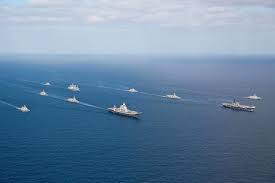India’s maritime surveillance is anchored by its advanced Coastal Surveillance Network (CSN), comprising 46 static radar stations strategically positioned along its 11,098 km coastline.
NEW DELHI: In the dynamic maritime environment of the Indo-Pacific, accurate surveillance and swift response capabilities are indispensable. Recent narratives from Pakistan have attempted to cast doubt on the Indian Navy’s preparedness, claiming vulnerabilities and questioning its strategic reliability. However, the realities of India’s robust Maritime Domain Awareness (MDA) capabilities and advanced electronic warfare (EW) and secure communications systems effectively dismiss such assertions, reinforcing India’s established role as a trusted regional security provider.
UNMATCHED MARITIME SURVEILLANCE INFRASTRUCTURE
India’s maritime surveillance is anchored by its advanced Coastal Surveillance Network (CSN), comprising 46 static radar stations strategically positioned along its 11,098 km coastline. These installations provide continuous, gap-free coverage, monitoring critical sea lanes vital to the Indian economy and broader Indo-Pacific stability. Recent expansions include stations in the Maldives, Myanmar, and Bangladesh, ensuring a multi-layered and cooperative approach to regional maritime security.
Complementing radar installations, India leverages sophisticated satellite assets, including the RISAT-series synthetic aperture radar (SAR) satellites and Cartosat-3, which offer sub-meter resolution imagery even in adverse weather conditions. India’s ambitious Space-based Surveillance-3 scheme aims to deploy 52 ISR satellites by 2026, significantly enhancing maritime reconnaissance capabilities and providing a persistent, real-time surveillance net.
This comprehensive approach directly negates Pakistani narratives, suggesting that India’s maritime vulnerabilities threaten its economic lifelines. India’s meticulous monitoring ensures the safety and reliability of sea lanes, which are crucial for its substantial crude oil imports and regional trade, demonstrating careful strategic planning rather than reckless endangerment of commerce.
IFC-IOR: A GLOBAL HUB FOR MARITIME INTELLIGENCE
The Information Fusion Centre-Indian Ocean Region (IFC-IOR) in Gurugram exemplifies India’s commitment to cooperative maritime security. Serving as a central hub, IFC-IOR synthesises real-time data from radars, satellites, and international partners, tracking upwards of 75,000 vessels continuously. The centre collaborates closely with 21 countries and 22 international maritime agencies, including key QUAD partners—the U.S., Australia, and Japan.
Recent initiatives, such as the 2023 agreement with Seychelles’ Regional Coordination Operations Centre to counter piracy, illegal fishing, and trafficking, highlight IFC-IOR’s proactive stance. By utilising advanced AI-driven analytics to identify suspicious maritime activity, India has established a transparent and internationalised maritime security framework, thereby dispelling any notions of weakening international trust. Indeed, IFC-IOR cements India’s position as a trusted maritime security partner in the wider Indo-Pacific, contrary to speculative narratives suggesting otherwise.
ADVANCED ELECTRONIC WARFARE DOMINANCE
Pakistan’s recent commentary highlighted the importance of boosting electronic warfare and secure communications to exploit the perceived vulnerabilities of the Indian Navy. Yet, India already maintains a significant edge in these very domains. Systems such as the indigenously developed Shakti EW suite—currently operational aboard capital warships like INS Vikrant—enable the Indian Navy to conduct comprehensive electronic countermeasures and defeat incoming missile threats. With production ramping up to equip more ships, this capability underlines India’s strategic preparedness rather than vulnerability.
Moreover, India’s EW systems provide multi-band jamming and signal intelligence, effectively paralysing hostile radar and communications. These capabilities have been consistently validated during extensive naval exercises, such as TROPEX and Malabar, directly countering adversarial threats and reinforcing operational dominance in electronic warfare.
SECURE, RESILIENT NAVAL COMMUNICATIONS
In secure communications, India’s indigenously deployed GSAT-7 (Rukmini) satellite provides dedicated, encrypted naval communication channels across warships, submarines, and aircraft, effectively eliminating reliance on foreign assets. Complementing this, Bharat Electronics Ltd’s STARS-V Mk III IP radios offer frequency-agile, AES-256 encrypted tactical networks. These advancements ensure the Indian Navy can maintain secure, resilient communication even under contested electronic environments—directly addressing and negating adversarial assertions of Indian vulnerability.
Annual tri-service cybersecurity exercises, incorporating advanced AI-driven threat detection systems against ransomware and zero-day cyber-attacks, further illustrate India’s commitment to secure and resilient naval operations, dispelling any Pakistani narratives that aim to portray Indian naval preparedness as compromised.
PROVEN OPERATIONAL EXCELLENCE AND REGIONAL LEADERSHIP
Operational exercises and real-world deployments further confirm India’s maritime preparedness. TROPEX 2025, India’s largest theatre-level naval exercise, featured over 65 vessels, including aircraft carriers INS Vikrant and INS Vikramaditya, demonstrating comprehensive integration of MDA, electronic warfare, and secure communications across a vast operational theatre. Similarly, Sea Vigil 2024 reinforced India’s multi-agency coastal defence, highlighting effective coordination across ministries and agencies in tackling complex maritime threats.
Furthermore, Operation Sindoor (2025) vividly showcased India’s rapid response capabilities, effectively deploying carrier battle groups (CBGs) with real-time maritime awareness, secure communications, and electronic dominance. Independent assessments from reputable international observers such as Eurasia Review and Forbes have explicitly acknowledged India’s precision, restraint, and technological superiority, reinforcing the Indian Navy’s regional dominance.
DISPELLING FALSE NARRATIVES AND REAFFIRMING TRUST
Assertions from Pakistani quarters claiming Indian naval operations lack strategic clarity or risk economic stability are demonstrably inaccurate. India’s multifaceted Maritime Domain Awareness (MDA) architecture, reinforced by international collaboration, ensures constant surveillance and secure navigation of critical sea lanes. Furthermore, robust EW and secure communication systems assure operational superiority against any potential threat, clearly refuting claims of vulnerability.
Far from an instrument of domestic political theatrics, as claimed, India’s strategic deployments and exercises underscore a responsible, calculated approach to maritime security firmly rooted in internationally respected norms and cooperation.
Further reinforcing India’s credibility as a strategic maritime partner, the Indian Navy regularly participates in high-profile exercises with key Indo-Pacific allies, notably within the QUAD framework. Annual exercises like Malabar, AUSINDEX, and JIMEX consistently demonstrate India’s operational excellence and strategic alignment with major maritime powers such as the United States, Australia, and Japan.
Naval commanders and defence ministries from these nations have repeatedly acknowledged the Indian Navy’s professionalism, technological capabilities, and leadership in joint maritime operations. Strategic think tanks, including the Observer Research Foundation (ORF) have also noted India’s indispensable role in shaping regional maritime security architectures. These robust partnerships and frequent high-level collaborations not only reinforce trust in India’s naval capabilities but effectively dispel any notion of diminished international confidence propagated by adversarial narratives.
A PROVEN MARITIME SECURITY PROVIDER
India’s advanced maritime domain awareness capabilities, electronic warfare superiority, and secure communication infrastructures effectively counter misleading claims from Pakistan aimed at questioning Indian naval preparedness and strategic reliability. With comprehensive surveillance networks, cutting-edge technological capabilities, and robust international partnerships, the Indian Navy clearly sets a global benchmark.
Rather than a liability, India’s naval power remains a vital component in securing economic lifelines and maintaining maritime stability across the Indo-Pacific. International trust and cooperation, alongside continuous modernisation, make the Indian Navy not only vigilant and prepared but, indeed, the gold standard in regional maritime security.
* Ashish Singh is an award-winning senior journalist with over 18 years of experience in defence and strategic affairs.








